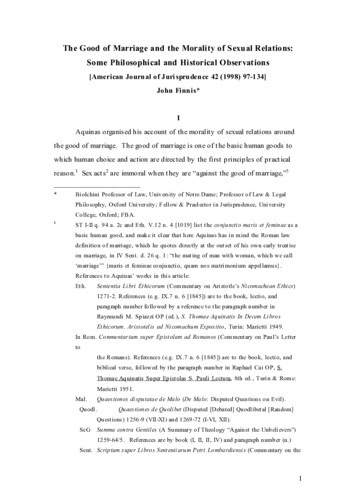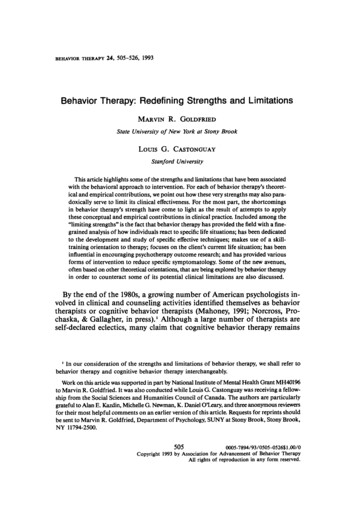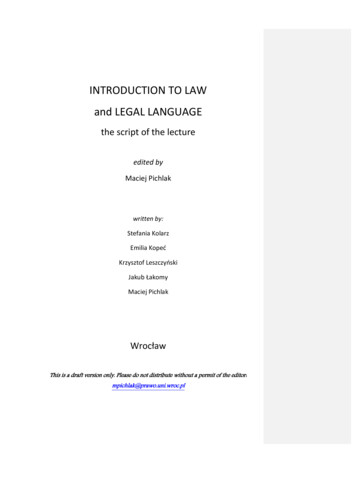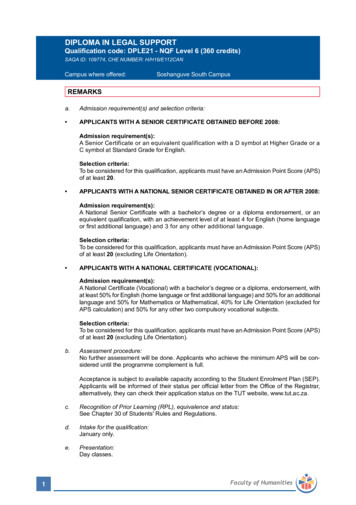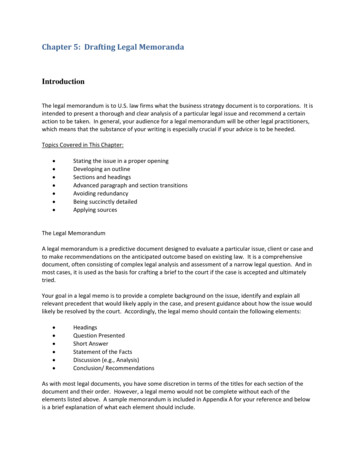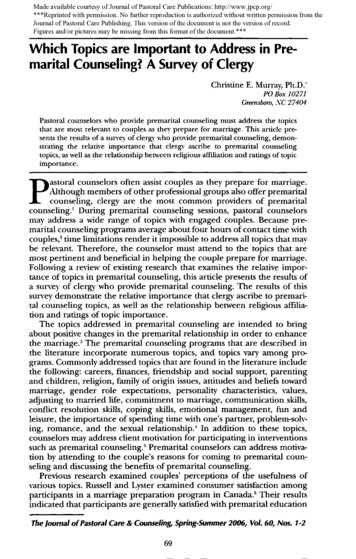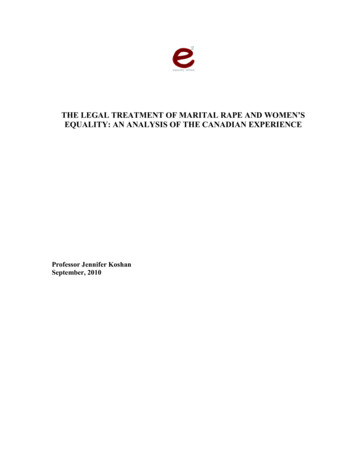
Transcription
THE LEGAL TREATMENT OF MARITAL RAPE AND WOMEN’SEQUALITY: AN ANALYSIS OF THE CANADIAN EXPERIENCEProfessor Jennifer KoshanSeptember, 2010
2Table of ContentsI.Introduction - The Legal Treatment of Marital Rape in Canada and Women’sEquality .3II.General Indicators of Women’s (In)equality and the Prevalence of Sexual Violence inCanada -- Setting the Stage for the Legal Treatment of Marital Rape . .4III.The Background to the Legal Treatment of Marital Rape in Canada – Colonial Influencesand EqualityResponses . . .10IV.The Legal Framework for Addressing Marital Rape in Canada .14V.Additional Laws, Policies and Reforms Affecting the Legal Treatment of Marital Rape inCanada. .17A.Sexual Assault: Definition and ElementsB.ConsentC.Mistaken Belief in ConsentD.Evidentiary RulesE.SentencingF.Other Laws, Policies and Reforms in the Area of Domestic ViolenceG.The Constitutional and International Frameworks for Marital Rape Laws inCanadaVI.The Judicial Treatment of Marital Rape in Canada 30A.IntroductionB.Sexual Assault: Definition and ElementsC.ConsentD.Mistaken Belief in ConsentE.Evidentiary RulesF.SentencingG.Other Equality IssuesH.Concluding Observations on the Case LawI.Towards Women’s Equality in Marital Rape Cases in CanadaVII.The Relevance of Legal Pluralism and Indigenous Law Perspectives .63VIII.Conclusion: Lessons Learned from the Legal Treatment of Marital Rape in Canada .65Appendix A 68
3The Legal Treatment of Marital Rape and Women’s Equality:An Analysis of the Canadian ExperienceBy Jennifer Koshan*September, 2010I.Introduction: The Legal Treatment of Marital Rape in Canada and Women’sEqualityMarital rape is both a product of and a contributing factor to women’s inequality in Canadiansociety and internationally. Nevertheless, before 1983 it was legally permissible for a man to rapehis wife in Canada without criminal sanction.1 A package of reforms to the Criminal Code wasenacted in 1983,2 and for the first time since confederation marital rape was categorized as acriminal offence. Contemporaneous and subsequent reforms to the sexual assault provisions inthe Criminal Code also recognized women’s equality and right to be free from sexual violence.However, the interpretation of these provisions by the courts, along with defence lawyer tacticsand lingering assumptions about sex in spousal relationships, have made it difficult to obtainappropriate legal remedies for marital rape in light of issues related to consent, mistaken belief inconsent, sexual history evidence and the production of personal records.3 Concerns also remainabout low rates of reporting marital rape and the treatment of those cases that are reported by thepolice, Crown prosecutors and courts.4 Few statistics are available on the impact of sexualviolence laws on marginalized men and women,5 and Indigenous peoples in Canada continue tobe denied sovereignty to deal with interpersonal violence according to their own laws.6This paper reviews the legal treatment of marital rape7 in Canada from the period when it wascriminalized in 1983 until the present. This review identifies further reforms and strategies* This paper was written for the equality effect (formerly the African and Canadian Women’s Human RightsProject). Many thanks to Susan McDonald, Fiona Sampson and Vasanthi Venkatesh for research assistance andcollaboration, and to the members of the ACWHRP marital rape subcommittee and participants in the Nairobiworkshop for their insights and comments. Particular thanks to Sheila McIntyre and Melanie Randall for theirdetailed comments on the paper, and to Elizabeth Sheehy for sharing resources. Also, my deep appreciation goes outto the law students from across the country who reviewed hundreds of cases to find and summarize those dealingwith marital rape: Antonio Giambardino, Miriam Gibbs, Brynne Harding, Michelle Johnston, Stephen Lajeunesse,Monica Lee, Nicole Ludwig, Charles McRoberts, Lindsay Merrifield, Gabrielle Motuz, Orlagh O'Kelly, CarolynStroz, Meghan Tonner, Elizabeth Whitsitt, and Miriam Yosowich.1Criminal Code of Canada, R.S.C. 1970, c. C-34.2Bill C-127, Act to amend the Criminal Code in relation to sexual offences and other offences against the person and toamend certain other Acts in relation thereto or in consequence thereof, S.C. 1980-81-82-83, c. 125.3See below section IIIB.4See below section II.5See below section II.6Of course, the denial of Indigenous peoples’ sovereignty goes far beyond issues relating to interpersonal violence.See Mary Eberts and Patricia Monture, “Is ‘Customary Law’ a Solution or a Continuing Problem of ColonialOppression: The Case of Aboriginal Women in Canada” (ACWHRP, 2010). I am also grateful for June McCue’scontributions to my thinking on this issue.7The term “marital rape” will be used in this paper even though “rape” is no longer an explicit offence since the1983 reforms. My use of this term is intended to describe the range of conduct that was subject to immunity prior to1983 as well as rapes and other sexual assaults occurring in spousal (or ex-spousal) relationships, regardless ofwhether the parties are (or were) legally married. My review of case law reveals that “rape” is still a frequent form ofsexual violence committed by husbands against their wives, so it seems appropriate to continue to use this term.
4required to respond properly to marital rape in Canada, and analyzes the lessons learned from theCanadian experience in order inform the reform of laws in Ghana, Kenya, and Malawi. In turn,similar analyses from Ghana, Kenya, and Malawi will inform the need and possibilities forreform and interpretation of the laws relating to marital rape in Canada. It is important to notethat there has been little specific attention paid to the issue of marital rape in Canada since theperiod when it was criminalized in 1983 and a short time thereafter when the impact of thereforms were assessed.8Section II of this paper provides the factual context for the legal analysis, including statistics ongeneral indicators of women’s (in)equality, the incidence and reporting of sexual violence inspousal relationships, and the harms of such violence. Section III details background to thecriminalization of marital rape in Canada, and section IV examines the overall framework for thelegal treatment of marital rape. Section V reviews other doctrinal factors influencing legalresponses to marital rape and violence in intimate relationships more broadly. Section VIanalyzes the judicial treatment of almost 300 reported cases of marital rape in Canada since 1983as a foundation for assessing the need and possibilities for further reforms to the law. Section VIIexplores the relevance of legal pluralism and indigenous law perspectives. Section VIII concludeswith lessons learned from the legal treatment of marital rape in Canada for reform of the law hereand elsewhere.II.General Indicators of Women’s (In)equality and the Prevalence of Sexual Violencein Canada -- Setting the Stage for the Legal Treatment of Sexual Violence in IntimateRelationshipsNumerous Canadian statistical and social science reports paint a picture of women’s (in)equality,and the harms, incidence rates and reporting rates of sexual violence and marital rape, as well asservices available (and gaps in services) to survivors of such violence. Viewed together, thesedata suggest the links among socio-economic inequality, being targeted for violence, and thefailures of law and the state to respond effectively and meaningfully to such human rightsbreaches.Statistics Canada’s most recent Gender-based Statistical Report reveals that women account forjust over half of the Canadian population (50.4%), with 19% of Canada’s female population bornoutside the country, 14% identifying themselves as “visible minorities”, and 3% identifying asAboriginal.9 More women (13.3%) than men (11.5%) report having disabilities.10 The number of8For exceptions see Christine Boyle, “Sexual Assault as Foreplay: Does Ewanchuk Apply to Spouses?” (2004) 20Crim. Reports 359 (“Boyle (2004)”); Melanie Randall, “Sexual Assault in Spousal Relationships, “ContinuousConsent”, and the Law: Honest But Mistaken Judicial Beliefs” (2008) 32 Manitoba Law Journal 144 (“Randall(2008)”); Elaine Craig, “Ten Years After Ewanchuk The Art of Seduction is Alive and Well: An Examination of theMistaken Belief in Consent Defence” (2009) 13(3) Can. Crim. L. Rev. 247; Ruthy Lazar, “Negotiating Sex – TheLegal Construct of Consent in Cases of Wife Rape in Canada” (forthcoming, C.J.W.L).9Statistics Canada, Women in Canada. A Gender-based Statistical Report (5th ed.) (Ottawa: Statistics Canada, 2006),on-line: 001-eng.pdf at 11.10Ibid. at 12, 54. This compares to World Health Organization statitstics which state that “at least 10% of all womenglobally” have disabilities. See The World Bank, Disability and Development, Women with Disability, MDK:20193528 menuPK:418895 pagePK:148956 piPK:216618 theSitePK:282699,00.html.
5women living in marriage relationships has declined over time, with 48% of women in thiscategory in 2001(down from 56% in 1981) and 9% of women living in common law relationshipsin 2001 (up from 4% in 1981).11In 2008, Canada placed 10th out of 93 countries on the UN’s Gender Empowerment Measure,which measures women’s activity in economic and political life, and 45th on the UN’s GenderDevelopment Index, which measures income equality and respect for human rights andfreedoms.12 More than half of Canadian women have some post-secondary educational training,but women are still slightly less likely to have a university degree, and far less likely to havegraduate degrees than men.13 The proportion of women in Canada working for pay has risen overthe years, from 42% in 1976 to 58% in 2001.14 However, women are much more often absentfrom work on account of family and personal responsibilities, and more likely to work part-timethan their male counterparts.15 Women’s choice of and participation in paid employment is oftenrelated to a lack of available or affordable child care.16 Women working full-time, full-year earnon average only 71.4% of what their male counterparts earn, and this number drops to 65.7% ifthe average earnings of all women workers are compared to their male counterparts.17 Womenworking in the paid workforce are also more likely to fall below the low-income cut off thanmen.18 Women are less likely than men to receive unemployment benefits, and make up 60% ofminimum wage earners. Given that women account for 47% of the paid workforce, this meansthat 1 out of 16 women earn minimum wage compared to 1 out of 25 men.19 Visible minoritywomen are better educated but less employed as well as more underemployed and underpaid thanwhite women.20 Aboriginal women are less likely to be employed than Aboriginal men or nonAboriginal women, with higher unemployment rates and lower income.21 Similarly, women withdisabilities are less likely to be employed than women without disabilities and men withdisabilities, and those who are employed have relatively low incomes.22 Overall, women aremuch more likely to be poor than men -- in 2007, 1.22 million adult women lived below thepoverty line, compared to 1.09 million men, and women are more likely to experience greaterdepth of poverty than men.23 Women who experience intersecting forms of inequality willexperience these social, political and economic disadvantages even more deeply.11Ibid. at 11. The remainder of women were single (17%), lone parents (9%), living at home with their parents(14%), or living with extended family (3%). Ibid. at 33.12Monica Townson, Women’s Poverty and the Recession (Ottawa: Canadian Centre for Policy Alternatives, 2009) at14-15, ault/files/uploads/publications/National Office Pubs/2009/Womens Poverty in the Recession.pdf13Statistics Canada (2006), supra at 90. 16% of men hold university degrees compared to 15% of women, whilewomen hold 44% of all masters degrees, and only 27% of all doctoral degrees.14Ibid. at 13.15Ibid. at 14. 7/10 of all part-time workers are women.16Monica Townson, supra at 24.17Ibid. at 16.18Statistics Canada (2006), supra at 14, reports that 31% of women fall below the LICO compared to 28% of men.For a discussion of the LICO as a measure of poverty see Townson, ibid. at 7.19Townson, ibid. at 24. 39% of women qualify for EI compared to 45% of men.20Statistics Canada (2006), supra at 249-50; Townson, ibid at 35.21Statistics Canada, ibid. at 198-9; Townson, ibid at 33-4.22Statistics Canada, ibid. at 294-296, Townson, ibid at 35-36.23Townson, ibid. at 10-11.
6Sexual violence is another indicator of women’s inequality. Statistics Canada reports that womenare 6 times more likely to be victims of sexual assault than men, and 3 times more likely to bevictims of criminal harassment. Women who experience violence know their abusers 70% of thetime, and 16% of women experiencing spousal abuse are sexually assaulted compared to a“statistically insignificant” proportion of males reporting spousal abuse.24Sexual violence is a serious intrusion of sexual and reproductive autonomy, bodily andpsychological integrity, and when it occurs in intimate relationships, it is also a breach of trustand can be a serious risk factor for femicide. A recent report of the Ontario Chief Coroner’soffice describes “prior forced sexual acts and /or assaults during sex” as an indicator for domestichomicide.25 Health Canada’s 2002 report The Family Violence Initiative discusses theconsequences of intimate violence (including sexual violence) for women, including physicalinjury, emotional harm, unwanted pregnancy, and exacerbation of other health conditions.26Women experiencing spousal violence are far more likely than men to be fearful, depressed, orsuffer anxiety attacks.27 For Indigenous women and perhaps other women as well, sexualviolence may also be seen as “a threat to health and security of the entire community.” 28 Poverty,social inequalities and the lack of available services may make it difficult for women to leaveviolent relationships, thus putting them at risk of further violence and harm.Conversely, intimate sexual violence may displace women from their homes and communitieswhen they do leave violent relationships. Statistics Canada biannually documents the usage ofshelters in Canada generally, and on “snapshot days” when women in shelters are surveyed togather information. A typical report shows that close to 80% of women in shelters on thesnapshot day were fleeing spousal abuse of some form,29 and between 30%30 and 23%31 wereescaping sexual abuse.3224Statistics Canada (2006), supra at 15, 161.Al J.C. O.Marra, Domestic Violence Death Review Committee Annual Report to the Chief Coroner (Ontario, 2005)at 86. See also R. v. E.M.B., 2000 ABQB 46, where spousal sexual violence was noted as a risk factor relevant to thedetermination of judicial interim release. In 2004, 37% of all female homicide victims were killed by a spouse orformer spouse. See Statistics Canada (2006), supra at 16, citing the 2004 General Social Survey. Ninety-seven percent of victims of murder-suicides are women (ibid. at 165).26Family Violence Initiative, The Family Violence Initiative: Year five report (Ottawa: Health Canada, 2002) at 1012.27Statistics Canada (2006), supra at 163.28Native Women’s Association of Canada, Proposed Amendments to the Criminal Code Under Bill C-49: ThePerspective of Aboriginal Women (NWAC, 1992) at 3. This was recognized in R. v. Betsidea, infra.29See for example Julie Sauvé and Mike Burns, Residents of Canada's shelters for abused women, 2008 (Ottawa:Statistics Canada, 2009) at 8, on-line: cle/10845-eng.pdf. Otherabusive relationships being escaped from were dating or family relationships (ibid. at 9). Also of note is that 25% ofwomen in shelters had reported the incident(s) to the police, and that 15% had obtained a restraining or protectionorder against the offender (ibid. at 10).30Daisy Locke and Ruth Code, Canada’s shelters for abused women, 1999/2000 (Ottawa: Statistics Canada, 2001) at6, on-line: -002-XIE/0010185-002-XIE.pdf (reporting onstatistics for April 17, 2000)31Andrea Taylor-Butts, Canada’s shelters for abused women, 2005/2006 (Ottawa: Statistics Canada, 2007) at 4, online: http://dsp-psd.pwgsc.gc.ca/collection 2007/statcan/85-002-X/85-002-XIE2007004.pdf (reporting on statisticsfor April 19, 2006).32While some of these reports indicate the number of shelters providing services for Aboriginal women, women withdisabilities, lesbian women, and racialized women, the rates of sexual violence in intimate relationships are notbroken down on this basis. Interestingly, the latest report (Sauvé and Burns, 2009, supra) does not include any25
7There are few specific statistics available on the incidence of sexual violence in intimaterelationships. The Canadian Panel on Violence Against Women (1993) reported on findings fromthe Women’s Safety Project,33 where 81% of sexual assaults in the survey sample wereperpetrated by men who knew their victims, and 38% were committed by husbands, common lawpartners or boyfriends. Although these statistics were not disaggregated, the Panel noted theunique vulnerability of some women to violence – poor women, racialized women, Aboriginalwomen, immigrant women, lesbian women, women with disabilities, older women, and ruralwomen. This increased vulnerability was tied to marginalized women’s systemic inequality anddevalued humanity, in addition to dependency on men or isolation.34 Health Canada’s report TheFamily Violence Initiative confirms statistics about the vulnerability of marginalized women tofamily violence, including Aboriginal women, women living in rural and remote communities,women with disabilities and ethno-cultural minority women.35Although the 1999 General Social Survey found comparable self-reported rates for male (7%)and female (8%) spousal violence over a 5 year period,36 it also found that women are morelikely to be subject to serious forms of domestic violence, including sexual assault (20% ofwomen and only 3% of men).37 Women who survive domestic violence are more likely to seekmedical attention than men (13% compared to 2%), and are 3 times more likely to fear for theirlives.38 According to the 2004 GSS, Aboriginal women are 3 times more likely to be victims ofspousal abuse than non-Aboriginal women, and Aboriginal women are more likely to experienceserious forms of spousal violence, including sexual assault (54% as compared to 37% of nonAboriginal victims).39 Visible minority and immigrant women were not found to be subject to agreater risk of spousal violence, and no specific findings were reported with respect to sexualviolence in intimate relationships for these groups.40 Another important statistic from the 1999GSS is that post-separation, 35% of women who were assaulted by their ex-partners weresexually assaulted.41information about services for marginalized women. The 2007 report includes a special focus on the needs ofAboriginal women, but does not deal specifically with sexual violence in intimate relationships.33Canadian Panel on Violence Against Women, Changing the Landscape: Ending Violence Achieving Equality(Ottawa: Minister of Supply and Services, 1993) at 30, citing Lori Haskell and Melanie Randall, The Women’s SafetyProject: A Community Based Study of Sexual Violence in Women’s Lives (Toronto: self-published, 1993). Thisproject was based on interviews with 420 women in Toronto.34Ibid. at 59.35The Family Violence Initiative, supra at 10-12.36Sandra Besserer, Jodi-Anne Brzozowski, Dianne Hendrick, Stacie Ogg, Catherine Trainor, A Profile of CriminalVictimization: Results of the 1999 General Social Survey (Ottawa: Statistics Canada, 2001) at 8 (“1999 GSS”), online: 001-eng.pdf. For a critique of the GSS methodology asrelated to the finding of equal rates of spousal violence, see FREDA, The 1999 General Social Survey on SpousalViolence: A Fact Sheet (on-line: 7Rebecca Kong, Holly Johnson, Sara Beattie and Andrea Cardillo, Sexual Offences in Canada (Ottawa: StatisticsCanada, 2003) at 6; on-line: -002-XIE/0060385-002-XIE.pdf .38Statistics Canada (2006), supra at 162, citing the 2004 General Social Survey.39Statistics Canada, ibid. at 163, citing the 2004 General Social Survey. See also NWAC (1992), supra at 3.401999 GSS, supra at 11.41See Tina Hotton, Spousal violence after marital separation (Ottawa: Statistics Canada, 2001) at 5. This figure wasdown from 46% in 1993 (ibid).
8A 2008 study by Justice Canada examined links between the high rates of family violence andsexual assault in the Territories and offenders’ past histories of abuse.42 It reports that in 2005,the rate of sexual assaults in Canada was 7.2 per 10,000 population, while in the Territories,which has a much higher Aboriginal population,43 the rate ranged from 79.7 per 10,000 inNunavut to 18.1 in the Yukon.44 Data from Crown prosecutor files were analyzed in relation toseparate categories of family violence and sexual assault cases, resulting in the finding that 4% ofsexual assaults were committed against current spouses or partners.In spite of these incidence rates, studies suggest that marital rape is vastly underreported topolice. Once again, there are no statistics gathered specifically for this form of violence.45However, general statistics on reporting rates for sexual assault are most likely apt in the contextof marital rape as well. Indeed, reporting rates are likely even lower for sexual violence in thecontext of spousal relationships, particularly if the parties remain together.46Statistics for reporting rates for sexual assault vary, but most studies show markedunderreporting. For example, the 1999 GSS found that 78% of sexual assaults were not reportedto police.47 Sexual Offences in Canada (2003) found that reported sexual offences increasedbetween 1983 (the year that reforms to the Criminal Code took effect)48 and 1993, after which thenumber of reported sexual offences declined by 36% between 1993 and 2002. However, 2002rates were still 47% higher than those in 1983.49 While this seems encouraging, empiricalresearch shows that it is difficult to isolate the actual impact of the reforms themselves from otherfactors that may have contributed to increased rates of reported sexual assaults.50 This researchconfirms the results of a number of studies conducted by Justice Canada (Research and StatisticsDivision) in the mid-1980s examining the impact of sexual assault law reforms in 1983 in sixCanadian cities. Researchers reviewed police, Crown and sexual assault centre files, undertookinterviews with criminal justice personnel, service providers, and victims, and engaged in courtmonitoring. There were some contradictory findings amongst the studies, but for the most part,they found that the reforms had not met the objective of encouraging reporting or of increasing42Anna Paletta, Understanding family violence and sexual assault in the Territories, First Nations, Inuit and MétisPeoples (Ottawa: Department of Justice Canada, 2008). Amongst Aboriginal persons in the sample, 66% of thoseaccused of sexual assault and 77% of those accused of family violence had abusive histories (at 25).43Rates of Aboriginal peoples in the Territories range from 85% in Nunavut to 23% in the Yukon. Ibid.44See also Sexual Offences in Canada (2003), supra at 4, showing markedly higher rates of police-reported sexualoffences in the three Territories.45This is based on a review of Statistics Canada’s annual reports on family violence, other government reports onfamily, domestic and sexual violence, reports on violence against Aboriginal women, a review of the Canadian Panelon Violence Against Women report, and a review of Canadian women’s shelter websites.46See Randall (2008) at 144.471999 GSS, supra at 39.48The 1983 reforms will be discussed in the next section of this paper.49Sexual Offences in Canada (2003), supra at 3. The actual figures are as follows: in 1983, 40 incidents of sexualassault per 100,000 population were reported to police; in 1993, 136 incidents per 100,000 were reported; in 2002,86 incidents per 100,000 were reported. These data are not broken down on the basis of race, class, disability, orother factors related to women’s marginalization. They are broken down by geographic region, showing greatvariation (ibid. at 4).50Sexual Offences in Canada (2003), ibid. See also Bernard Schissel, "Law Reform and Social Change: A TimeSeries analysis of Sexual Assault in Canada" (1996), 24(2) Journal of Criminal Justice 123, whose empirical researchsuggests that any changes in arrest and charging rates for sexual assault are attributable to general trends in socialcontrol rather than the impact of sexual assault law reforms.
9convictions for sexual offences. 51 Reporting rates may also be lower for particular groups ofwomen. For example, the Native Women’s Association of Canada indicates that fewerAboriginal women report sexual violence to the police because of a lack of trust of and alienationfrom the Canadian justice system.52 Women with disabilities may also underreport sexualviolence.53Those sexual offences that are reported are less likely than other violent offences to be considered“founded”, and less likely to result in charges, prosecutions, or convictions. Sexual Offences inCanada (2003) reported that 16% of sexual offences were deemed unfounded in 2002, comparedwith a 7% unfounded rate for other violent crimes between 1991 and 2002. Further, only 44% offounded sexual offences were cleared by the laying of charges, compared to 50% of otherfounded violent offences.54A Survey of sexual assault survivors conducted by the Department of Justice in 2000 providessome context for why sexual assault survivors choose to report sexual violence (or not). Thissurvey found a much higher reporting rate of sexual violence than the reports noted above, with64 out of 102 survey respondents having reported to the police. Perpetrators were arrested in 43out of 64 of the reported cases, charges were laid in 39 out of 64 cases, and convictions wereobtained in 18 out of 30 cases.55 Women indicated their reasons for reporting the sexual violenceto the police, including a desire to expose or punish the perpetrator, to protect themselves, theirchildren, or other women, and for personal healing. The women’s reasons for not reporting51J. and J. Research Associates Ltd., An Evaluation of the Sexual Assault Provisions of Bill C-127, Fredericton andSaint John, New Brunswick (1988); Ekos Research Associates Inc., Report of the Impact of the 1983 Sexual AssaultLegislation in Vancouver, British Columbia (1988); Ekos Research Associates Inc., Report of the Impact of the 1983Sexual Assault Legislation in Hamilton-Wentworth (1988); University of Manitoba Research Ltd., Social SciencesDivision, Report of the Impact of the 1983 Sexual Assault Legislation in Lethbridge, Alberta (1988); University ofManitoba Research Ltd., Social Sciences Division, Report of the Impact of the 1983 Sexual Assault Legislation inWinnipeg, Manitoba (1988). The need for public education and awareness, victim support services, and training ofjustice system personnel was identified in these evaluations.52NWAC (1992), supra at 4. Sheila McIntyre, "Second Wave Feminist Activism Against Sexual Assault: 19702010" (unpublished, on file with author) notes at 22 that Aboriginal women may also decline to report sexualassaults “because children born of the rape of a status Indian woman by a white man were denied Indian status”, thusshowing how colonial laws contributed to underreporting.53Janine Benedet and Isabel Grant, “Hearing the Sexual Assault Complaints of Women with Mental Disabilities:Consent, Capacity, and Mistaken Belief” (2007) 52 McGill L.J. 243 at 256, citing Deborah Tharinger, ConnieBurows Horton & Susan Millea, “Sexual Abuse and Exploitation of Children and Adults with Mental Retardationand Other Handicaps” (1990) 14 Child Abuse and Neglect 301 at 304 (estimating a 1 in 30 reporting rate for womenwith disabilities, compared to 1 in 5 for women without disabilities).54Sexual Offences in Canada (2003), supra at 9. Of all founded sexual offences, 37% were not cleared by charges orotherwise, compared to 28% of other violent offences (ibid.). For recent analyses of unfounding in sexual assaultcases, see Teresa DuBois, “A Critical Analysis of Police Investigation: The “Wrongful Unfounding” of SexualAssault Complaints” and A. Blair Crew, “Striking Back: The Viability of a Civil Action against the Police for the“Wrongful Unfounding” of Reported Rapes”, both forthcoming in Elizabeth Sheehy, ed., Sexual Assault Law,Practice & Activism in a Post-Jane Doe Era (Ottawa: University of Ottawa Press, 2011).55Tina Hattem, Survey of sexual assault survivors (Ottawa: Department of Justice Canada, 2002) at 9-10. Surveyswere conducted by telephone with women recruited by sexual assault centres in Ontario, B.C., Nova Scotia andNewfoundland. It is unclear how many of these cases involved sexual violence in spousal relationships, andresponses were not disaggregated.
10included fear of or previous negative experiences with the criminal justice system, fear of recorddi
Monica Lee, Nicole Ludwig, Charles McRoberts, Lindsay Merrifield, Gabrielle Motuz, Orlagh O'Kelly, Carolyn Stroz, Meghan Tonner, Elizabeth Whitsitt, and Miriam Yosowich. 1 Criminal Code of Canada, R.S.C. 1970, c. C-34. 2 Bill C-127, Act to amend the Criminal Code in relation to sexual offences and other offences against the person and to


